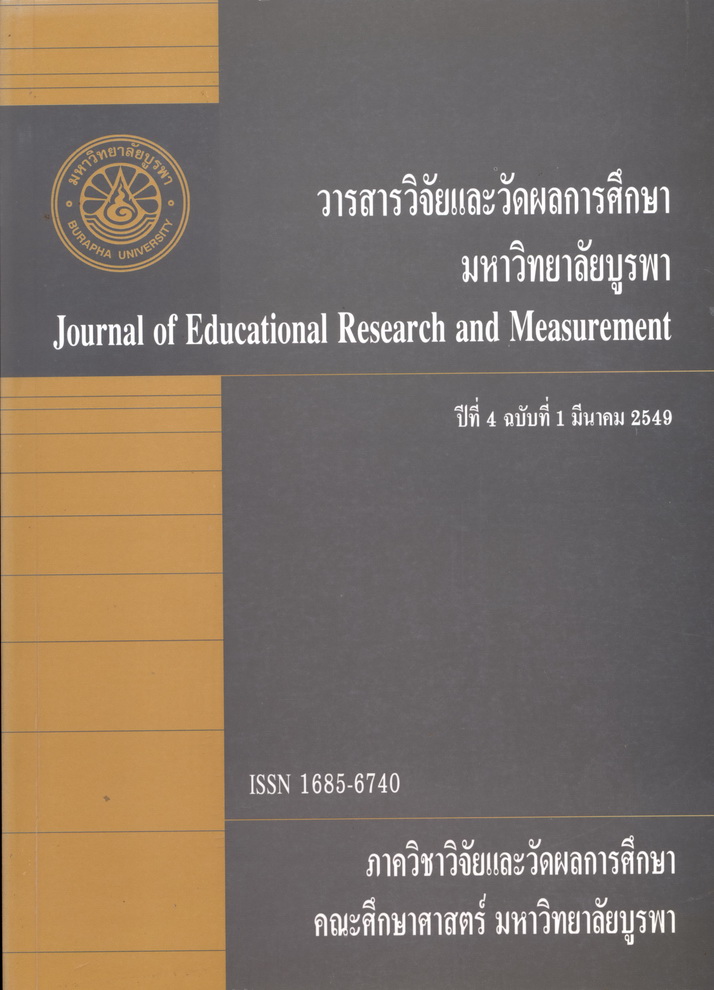โมเดลความสัมพันธ์เชิงสาเหตุของแบบการเรียนของนักเรียนชั้นมัธยมศึกษาปที่ 6
Main Article Content
Abstract
การวิจัยนี้มีวัตถุประสงคเพื่อพัฒนาและตรวจสอบความตรงเชิงโครงสรางของโมเดลความสัมพันธเชิงสาเหตุ ของแบบการเรียนของนักเรียนชั้นมัธยมศึกษาปที่ 6 ตามแนวคิดของกราซาและไรชมานน (Grasha & Reichmann, 2006) แบบการเรียนของนกเรั ียน 6 แบบไดแก แบบแขงขันแบบรวมมือแบบหลกเลี ี่ยงแบบมีสวนรวม แบบพึ่งพาและแบบอิสระ กลุมตวอย ั างเปนน กเรั ียนชนมั้ ัธยมศึกษาปท 6 ี่ ในโรงเรียนสังกัดสานํ กงานคณะกรรมการการศ ั กษาข ึ นพั้ นฐาน ื้ ปการศึกษา 2545 จํานวน 1,000 คน โมเดลประกอบดวยต วแปรอ ั ิสระ 4 ตวั ไดแก ลกษณะส ั วนบุคคล สภาพครอบครวั สงแวดล ิ่ อม ทางการเรียน และแรงจูงใจในการเรียน ตัวแปรตามเปนแบบการเร ียน เครองม ื่ ือที่ใชในการวิจยประกอบด ั วยแบบสอบถาม ปจจัยที่มีอทธิ พลต ิ อแบบการเร ียนและมาตรวดแบบการเร ั ยนของน ี กเรั ียน การวิเคราะหขอมลใช ู โปรแกรม SPSS คํานวณ คาสถิตพิื้นฐานและใชโปรแกรม LISREL 8.50 ตรวจความตรงเชิงโครงสรางของโมเดลความสัมพันธเชิงสาเหตุ ผลการวิจัยปรากฏวา โมเดลความสัมพนธั เชิงสาเหตุของแบบการเรียนของนักเรียนชั้นมัธยมศึกษาปท 6 ี่ ทั้ง 6 แบบ ไดแก แบบการเรียนแบบแขงขันแบบรวมมอืแบบหลีกเลี่ยงแบบมีสวนรวม แบบพึ่งพาและแบบอิสระ มีความสอดคลอง กับขอมูลเชิงประจักษมีคาไค-สแควรตั้งแต 0.40 ถึง 50.37, คา p ตั้งแต .13 ถึง 1.00, ดัชนี GFI เทากับ 1.00, ดัชนี AGFI ตั้งแต .97 ถึง 1.00, ดัชนี CFI เทากับ 1.00, คา SRMR ตั้งแต .002 ถึง .019, คา RMSEA ตั้งแต .00 ถึง .01 คาสัมประสิทธิ์การ พยากรณตั้งแต .36 ถึง .99 แสดงวาทุกโมเดลสอดคลองกับขอมูลเชิงประจักษอยูในเกณฑดี ตัวแปรที่มีอทธิ ิพลทางตรงตอทุกแบบการเรียนคือแรงจูงใจในการเรียนโดยสงผลในทิศทางบวกกับแบบการเรียน แบบแขงขัน แบบรวมมือ แบบมีสวนรวม และแบบอสระ ิ แตสงผลในทิศทางลบตอแบบการเรียนแบบหลกเลี ี่ยง และ แบบพึ่งพาแรงจูงใจในการเรียนมีอิทธิพลทางตรงมากทสี่ ุดตอแบบการเรียนแบบหลีกเลี่ยง แบบอิสระและแบบแขงขัน สภาพครอบครัวมีอิทธิพลทางตรงมากที่สุดตอแบบการเรียนแบบพึ่งพา และแบบรวมมือ สิ่งแวดลอมทางการเรียน มีอิทธิพลมากที่สุดตอแบบการเรียนแบบมีสวนรวม
CAUSAL RELATIONSHIP MODELS OF LEARNING STYLES FOR GRADE 12 STUDENTS
The purpose of this research was to develop and check the construct validity of the causal relationship models of learning styles of Grade 12 students, based on the concepts of Grasha & Reichmann (2006). Six models were involved, namely : Competitive Learning Style, Collaborative Learning Style, Avoidance Learning Style, Participant Learning Style, Dependent Learning Style, and Independent Learning Style. The sample consisted of 1,000 Grade 12 students from schools under the Juris diction of the Office of the Basic Education Commission, academic year 2002. The models consisted of four independent variable groups: Personal Characteristics, Family Status, Learning Environment, and Learning Motivation. The dependent variable was Learning Style. The research instruments included a questionnaire on factors influencing learning styles, and a Learning Styles scale. Data were analyzed through SPSS and LISREL 8.50. The results indicated that all six models were consistent with empirical data, with chi-square goodness of fit tests ranging from 0.40 to 50.37, p from .13 to 1.00, GFIs at 1.00, AGF I from .97 to 1.00, CFIs at 1.00, SRMR from .002 to .019, RMSEAs from .00 to .01, and R-squares from .36 to .99. The variable that had direct influence on Learning Style in all models was Learning Motivation. Other positive influences were found with Competitive Learning Style, Collaborative Learning Style, Participant Learning Style, and Independent Learning Style. On the other hand, Learning Motivation negatively influenced Avoidance Learning Style, and Dependent Learning Style. The highest direct influence on Avoidance Learning Style, Independent Learning Style, and Competitive Learning Style, was Learning Motivation. The highest direct influence on Dependent Learning Style, and Collaborative Learning Style, was Family Status. The highest direct influence on Dependent Learning Style was Learning Environment.
